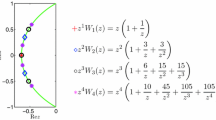Abstract
A discrete finite-difference time-domain (FDTD) method based on Maxwell’s equations is proposed to solve the scattered-field equation for dispersive media. The equations for the scattered field in a plasma medium are first derived, then used to calculate the radar cross-section (RCS) of three-dimensional targets, viz. a plasma sphere and a rectangular plate. When using such an FDTD method to compute the far-field scattering characteristics of a target, the near- to far-field transformation technique is generally required, which involves artificial setting a connection boundary between the total and scattered field in the computational space in order to calculate the latter and thereby the RCS of the target. This connection boundary must be set separately and appropriate computational grids added. However, by discretizing the Maxwell’s equations describing the scattered field, the resulting field in the computational space is already the scattered field and can be used directly to calculate the far-field properties of the target. In this way, the additional processing for the edge of the scattered field and computational space is avoided. Numerical calculations herein show that this FDTD approach for the scattered field is universal to some extent, being suitable for not only homogeneous but also dispersive media.






Similar content being viewed by others
References
Teixeira, F.L., Chew, W.C.: Finite-difference computation of transient electromagnetic waves for cylindrical geometries in complex media. IEEE Trans. Geosci. Remote Sens. 38(4), 1530–1543 (2000)
Chen, W., Guo, L., Li, J., Liu, S.: Research on the FDTD method of electromagnetic wave scattering characteristics in time-varying and spatially nonuniform plasma sheath. IEEE Trans. Plasma Sci. 44(12), 3235–3242 (2016)
Liu, J.-X., Xu, H.-Y., Yang, Z.-K., Xie, X., Zhang, Y., Yang, H.-W.: A research of magnetic control ferrite photonic crystal filter. Plasmonics 12(4), 971–976 (2017)
Mukherjee, B., Vishwakarma, D.K.: Application of finite difference time domain to calculate the transmission coefficient of an electromagnetic wave impinging perpendicularly on a dielectric interface with modified MUR-I ABC. Def. Sci. J. 62(4), 228–235 (2012)
Mukherjee, B.: Numerical solution in FDTD for absorbing boundary condition over dielectric surfaces. J. Adv. Res. Sci. Comput. IASR 4(1), 13–23 (2012)
Jian-Xiao, L., Jun-Liang, Z., Ming-Min, S.: Finite-difference time domain method for the analysis of radar scattering characteristic of metal target coated with anisotropic ferrite. Acta Phys. Sin. 63(13), 137501–6 (2014). (in Chinese)
Malcolm, N.P., Heltzel, A.J., Sokolov, K.V., Shi, L., Howell, J.R.: Simulation of a plasmonic tip-terminated scanning nanowire waveguide for molecular imaging. Appl. Phys. Lett. 93(19), 193101–3 (2008)
Xiang, G., Yun-hua, Z.: Near-field radar imaging simulation based on FDTD method. J. Microwav. 24(1), 1–6 (2008). (in Chinese)
Patil, D.S., Gautam, D.K.: Computer analysis and optimization of physical and material parameters of the blue laser diode. Opt. Commun. 201(4–6), 413–423 (2002)
Samuel, E.P., Bhole, M.P., Patil, D.S.: Mode confinement and near field intensity analysis in a GaN-based blue–green laser diode. Semicond. Sci. Technol. 21(8), 993–997 (2006)
Talele, K., Samuel, E.P., Patil, D.S.: Investigation of near field intensity in GAN MQW in 300–375 nanometer wavelength ranges. J. Electromagn. Waves Appl. 22(8–9), 1122–1130 (2008)
Talele, K., Patil, D.S.: Analysis of wave function, energy and transmission coefficients in GaN/AlGaN superlattice nanostructures. Prog. Electromagn. Res. 81, 237–252 (2008)
Shao-Bin, L., Jin-Jun, M., Nai-Chang, Y.: A JEC-FDTD implementation for anisotropic magnetized plasmas (in Chinese). Acta Phys. Sin. 53(3), 783–787 (2004)
Sullivan, D.M.: Frequency-dependent FDTD methods using Z transforms. IEEE Trans. Antennas Propag. 40(10), 1223–1230 (1992)
Mosallaei, H.: FDTD-PLRC technique for modeling of anisotropic-dispersive media and metamaterial devices. IEEE Trans. Electromagn. Compat. 49(3), 649–660 (2007)
Hong-Wei, Y., Ru-Shan, C., Yun, Z.: SO-FDTD method and its application to the calculation of electromagnetic wave reflection coefficients of plasma. Acta Phys. Sin. 55(7), 3464–3469 (2006). (in Chinese)
Liu, J.-X., Zhang, L.-X., Zhang, J.-L., Yang, Z.-K., Yang, H.-W.: Anisotropic ferrite microstrip antenna simulation and analysis. Optik 127(8), 4144–4149 (2016)
Jiang, Y.-N., Ge, D.-B., Ding, S.-J.: Analysis of TF-SF boundary for 2D-FDTD with plane P-wave propagation in layered dispersive and lossy media. Prog. Electromagn. Res. 83, 157–172 (2008)
Xiaojuan, H., Debiao, G., Bing, W.: 3D FDFD algorithm with TF/SF technique for electromagnetic scattering from a composite target. Chin. J. Comput. Phys. 25(3), 309–314 (2008). (in Chinese)
Schneider, J.B.: Plane waves in FDTD simulations and a nearly perfect total-field/scattered-field boundary. IEEE Trans. Antennas Propag. 52(12), 3280–3287 (2004)
Elsherbeni, A., Demir, V.: The Finite-Difference Time-Domain Method for Electromagnetics with MATLAB Simulations. National Defense Industry Press, Beijing (2012)
Beggs, J.H., Luebbers, R.J., Kunz, K.S.: User’s manual for three dimensional FDTD version B code for scattering from frequency-dependent dielectric materials. NASA, Tech. Rep. N92–19738, 1–31 (1992)
Kong, S.-C., Simpson, J.J., Backman, V.: ADE-FDTD scattered-field formulation for dispersive materials. IEEE Microw. Wirel. Compon. Lett. 18(1), 4–6 (2008)
Kalluri, D.K.: Electromagnetic Waves, Materials, and Computation with MATLAB. CRC Press, Boca Raton (2011)
Xu, L., Yuan, N.: JEC-FDTD for 2-D conducting cylinder coated by anisotropic magnetized plasma. IEEE Microw. Wirel. Compon. Lett. 15(12), 892–894 (2005)
Yu-Bo, Y., Hui, D., Qing-Liang, L.: Analysis for scattering of 3-dimentional target coated with plasma by PLRC-FDTD technique. Chin. J. Radio Sci. 22(4), 563–566 (2007). (in Chinese)
Xiao-chun, X., Kun, Z.: Analyzing RCS of 3D aircraft using finite difference algorithm. J. Kunming Univ. Sci. Technol. (Sci. Technol.) 32(1), 23–27 (2007). (in Chinese)
Debiao, G., Yubo, Y.: Finite-Difference Time-Domain Method for Electromagnetic Waves, 2nd edn. Xidian University Press, Xi’an (2005). (in Chinese)
Mätzler, C.: MATLAB functions for Mie scattering and absorption. In: Research Report, No. 2002-08 (2002).
Acknowledgements
This work is supported by the Natural Science Foundation of China (grant no. 11674174) and the Excellence Project of Nanjing Agricultural University (grant no. JF17080123).
Author information
Authors and Affiliations
Corresponding author
Rights and permissions
About this article
Cite this article
Liu, JX., Ju, L., Meng, LH. et al. FDTD method for the scattered-field equation to calculate the radar cross-section of a three-dimensional target. J Comput Electron 17, 1013–1018 (2018). https://doi.org/10.1007/s10825-018-1162-4
Published:
Issue Date:
DOI: https://doi.org/10.1007/s10825-018-1162-4




